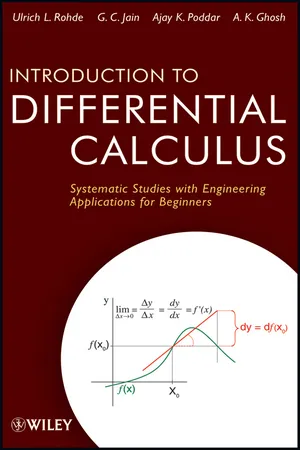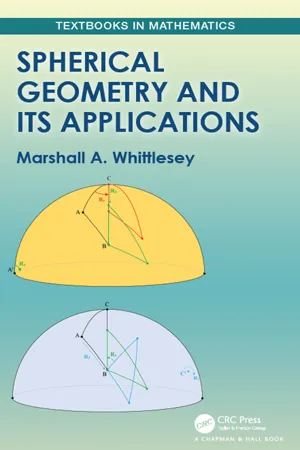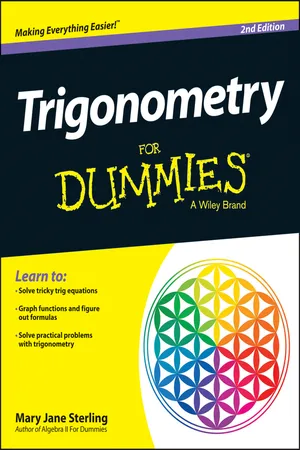Mathematics
Double Angle and Half Angle Formulas
Double angle and half angle formulas are trigonometric identities that express the sine, cosine, and tangent of double or half angles in terms of the sine and cosine of the original angle. These formulas are useful for simplifying trigonometric expressions and solving trigonometric equations. They are derived from the sum and difference identities for sine and cosine functions.
Written by Perlego with AI-assistance
Related key terms
Related key terms
1 of 4
Related key terms
1 of 3
5 Key excerpts on "Double Angle and Half Angle Formulas"
- eBook - ePub
Foundations of Mathematics
Algebra, Geometry, Trigonometry and Calculus
- Philip Brown(Author)
- 2016(Publication Date)
- Mercury Learning and Information(Publisher)
can be negative, so a negative sign might be needed in front of the square root on the RHS. Thus, the half-angle identity for the sine ratio isSimilarly, using formula (4.15b), we can obtain the half-angle identity for the cosine ratio:EXAMPLE 4.12.2. In Example 4.11.2 , the value of was found by making use of an addition identity. This value can also be computed using formula (4.16):Now, this answer does not look the same as the answer in example 4.11.2 , which was However, by comparing the squares of the answers, it is clear that they are the same:An approximation of the identity in the next example was used by the Indian Mathematician Aryabhata in about 500 AD to construct a table of sines.EXAMPLE 4.12.3. Prove thatAnswer:The LHS equals the RHS, so the identity is proved.4.13SOLVING TRIANGLES
Any triangle has six parts: three sides and three angles. If any three parts of a triangle are given (with at least one of these being the length of a side), then in most cases we can calculate unambiguously what the other parts are by means of the formulas that are derived in this section. In particular, if the triangle is a right triangle, then one angle (the right angle) is automatically given, and if any two other parts are given (with at least one of these being the length of a side), then the trigonometric ratios automatically determine what the other parts are.4.13.1Right Triangles
The connection between right triangles and trigonometric ratios has already been indicated a few times in this chapter. Any right triangle can be oriented in the Cartesian plane, so that either of its acute angles coincides with an angle measured in a counterclockwise direction from the x-axis; that is, one vertex is situated at the origin, one side (not the hypotenuse) is aligned with the positive x-axis, and the hypotenuse radiates from the origin to another vertex of the right triangle in the first quadrant. The side along the x-axis is called the adjacent side, and the side perpendicular to it is called the opposite side, as shown in figure 4.29 . If the coordinates of the vertex in the first quadrant are labeled (a, b), then the length of the adjacent side is a, the length of the opposite side is b, and the length of the hypotenuse is If the angle at the origin is labeled θ, then, according to the definition of the trigonometric ratios, sin(θ) is the length of the opposite side divided by the length of the hypotenuse (opposite over hypotenuse, for short), cos(θ) is the length of the adjacent side divided by the length of the hypotenuse (adjacent over hypotenuse, for short), and tan(θ) is the length of the opposite side divided by the length of the adjacent side (opposite over adjacent - eBook - ePub
- Colin Beveridge(Author)
- 2016(Publication Date)
- For Dummies(Publisher)
It’s extremely unusual to see these come up in an exam, but they’re technically fair game, and with the recent trend towards deliberately setting bloodbath questions, I’d not be too surprised to see them in the next few years. Compound angle formulas Your formula book gives you three compound angle formulas: This may be the first time you’ve seen the odd-looking sign. It shows up only when you have a, and it means ‘Whichever sign you picked before, you pick the other one here.’ The cosine formula is a shorthand for and. If you know the trigonometric ratios of a few common angles, you can use them and the compound angle formulas to work out the ratios of other angles. For example,. Using and, you get the following: Rationalising, you get, which you can check on your calculator. I’m being a bit obstinate in using radians here – you’re slightly more likely to see this in degrees – but the same formulas apply. Radians are just better. Double-angle formulas The double-angle formulas are a direct consequence of the compound angle formulas. For example, you could find by noticing it’s, expanding and simplifying. If you did that, you’d find the following:, which can be rewritten as The last of those is significantly less common than the others, but they’re all worth knowing. They’re especially helpful for three-theta kinds of questions, which might say something like ‘Show that.’ Here’s how to do that: Split up into and expand the left-hand side of the given problem. Expand everything with a in it. You’re looking for sines, so pick expansions that make your life easy. There’s only one expansion for, but I’d use to make the left-hand side into Get rid of any rogue things you don’t want. For example, that can become - eBook - ePub
Introduction to Differential Calculus
Systematic Studies with Engineering Applications for Beginners
- Ulrich L. Rohde, G. C. Jain, Ajay K. Poddar, A. K. Ghosh(Authors)
- 2012(Publication Date)
- Wiley(Publisher)
Chapter 5 Trigonometry and Trigonometric Functions 5.1 IntroductionThe word trigonometry is derived from two Greek words, together meaning measuring the sides of a triangle . The subject was originally developed to solve geometric problems involving triangles. One of its uses lies in determining heights and distances , which are not easy to measure otherwise. It has been very useful in surveying , navigation , and astronomy . Applications have now further widened.At school level, in geometry, we have studied the definitions of trigonometric ratios of acute angles in terms of the ratios of sides of a right-angled triangle.Note that in the right-angled triangle OAR , if the lengths of the sides are respectively denoted by B (for base), P (for perpendicular), and H (for hypotenuse), as shown in Figure 5.1 , then the angle θ (in degrees) is an acute angle (i.e., 0° < θ < 90°). It is for such angle(s) that we have defined trigonometric ratios in earlier classes.1Figure 5.1 Right angled triangle defining trigonometric ratios.Now, in our study of trigonometry, it is required to extend the notion of an angle in such a way that its measure can be of any magnitude and sign . Once this is done, the trigonometric ratios are defined for angles of all magnitudes and sign. Finally, by identifying these magnitudes and signs of angles, with real numbers, we say that the trigonometric ratios of directed angles represent trigonometric functions of real variables - eBook - ePub
- Marshall Whittlesey(Author)
- 2019(Publication Date)
- Chapman and Hall/CRC(Publisher)
4.53 ), we findsin 2(=C 2)sin(sins − a)(s − b)sin( a )sin( b )(4.54) Since ≺C is an angle of a triangle, 0 < C < π, so 0 <⋄, and for such aC 2<π 2C 2, the sine is always positive, so we can solve (4.54 ) by taking a square root to obtain (4.49 ). The equation (4.50) is proven similarly and is left as an exercise (or see §19.) The equation (4.51) is found by dividing the first two.Similar formulas can be found for ≺A and ≺B by permuting the vertices. These formulas allow one to calculate an angle in terms of the sides. Of course, the reader might wonder why we would need such a formula, given that we can easily solve for cos(C) as in (4.52 ). The reason is partly historic: prior to the invention of electronic computers, a formula was valued if it was easy to use with logarithms. The mathematician would have at his disposal tables of values of trigonometric, inverse trigonometric, exponential, and logarithmic functions. Decimal values obtained from those tables would be easy to add and subtract, but difficult to multiply and divide where needed. With the half-angle formulas, one would take the logarithm of both sides and use the laws of logarithms to break the expression into sums of pieces, all of which would have the form of the composition of a logarithm and a trigonometric function. Each term could be calculated. Then they would all be added together, and one could get the value ofC 2by first exponentiating the right side and then taking an inverse trigonometric function. For example, with (4.49 ), if we take the natural logarithm ln of both sides, we obtainln(=sin)(C 2)1 2(,ln)(+ lnsin)(s − a)(− lnsin)(s − b)(− lnsin)( a )(sin)( b )using the laws of logarithms. Given a, b and c, only addition and subtraction is required to obtain s − a and s − b. If we have a table of the ln(sin(·)) function, we may obtain the entire right side via addition, subtraction, and division by 2. We then have the value of ln(sin(C 2)). Using the (inverse of the) ln(sin(·)) table again, we find the value ofC 2, and then C - No longer available |Learn more
- Mary Jane Sterling(Author)
- 2014(Publication Date)
- For Dummies(Publisher)
T he six basic trig functions all had humble beginnings with the right triangle and its angles. The unit circle opens up a whole new world for the input values into those functions. Because of the nature of trig functions — they repeat the same patterns over and over — the output values show up regularly. This repetition is a good thing; you recognize where in the pattern a particular input belongs and then assign the output. Life is good.Defining Trig Functions for All Angles
So many angles are used in trigonometry and other math areas, and the majority of those angles are multiples of 30 and 45 degrees. So, having a trick up your sleeve letting you quickly access the function values of this frequent-flier list of angles makes perfect sense. All you need to know or memorize are the values of the trig functions for 0-, 30-, 45-, 60-, and 90-degree angles in order to determine all the trig functions of all the angles, positive or negative, that are multiples of 30 or 45 degrees, which are the two most basic, foundational angles. Finding these function values for a particular angle is a three-step process: (1) Find the measure of the angle's reference angle, (2) Assign the correct numerical value, and (3) Determine whether the function value is positive or negative.Putting reference angles to use
The first step to finding the function value of one of the angles that's a multiple of 30 or 45 degrees is to find the reference angle. When the reference angle comes out to be 0, 30, 45, 60, or 90 degrees, you can use the function value of that angle and then figure out the sign (see the next section). Use Table 8-1 or Table 8-2 to find the reference angle.All angles with a 30-degree reference angle have trig functions whose absolute values are the same as those of the 30-degree angle. The sines of 30, 150, 210, and 330 degrees, for example, are all either or . Likewise, using a 45-degree angle as a reference angle, the cosines of 45, 135, 225, and 315 degrees, for example, are all or
Index pages curate the most relevant extracts from our library of academic textbooks. They’ve been created using an in-house natural language model (NLM), each adding context and meaning to key research topics.
Explore more topic indexes
Explore more topic indexes
1 of 6
Explore more topic indexes
1 of 4




